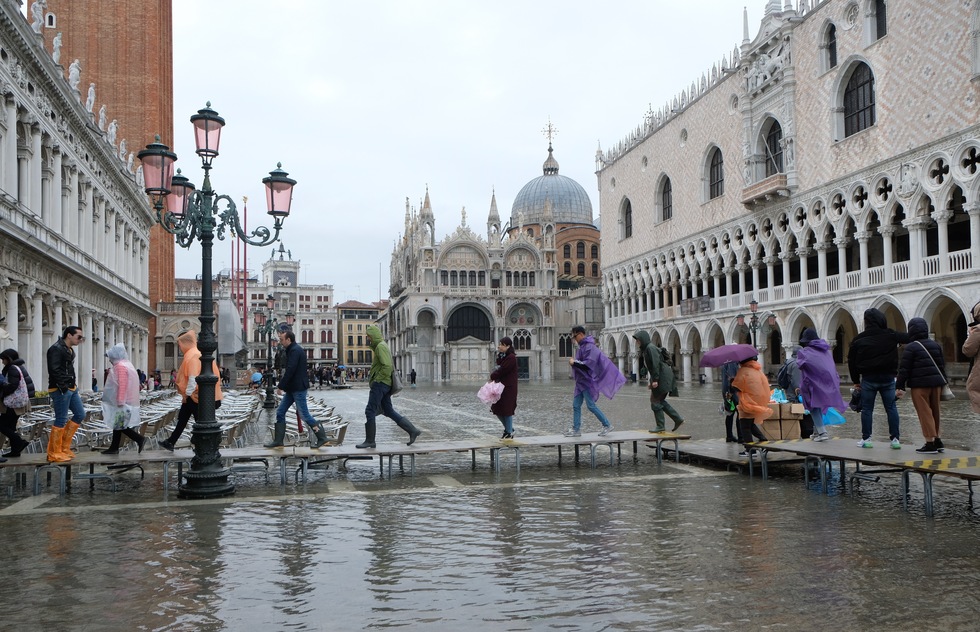Venice, Italy’s, extreme high tides increasingly make international news, with desperate scenes of shopkeepers and restaurant owners assessing their flooded businesses and, worse yet, heartbroken conservators at St. Mark’s Basilica trying to put a price tag on the city’s deluged treasures.
But all the tourists don’t go away when the waters rise. How can tens of thousands of daily visitors to Venice cope while the city’s iconic square, Piazza San Marco, is shin-deep in water? And if you find yourself in Venice when the acqua alta—or high water, as the seasonal high tides are called here—rolls in, what should you do?
Gioele Romanelli’s family has operated Hotel Flora, a 5-minute walk from Piazza San Marco, for more than 50 years. The acqua alta, he explains, is just a way of life in Venice. The events usually occur 3 or 4 times in the winter, most frequently in November and December, when seasonally higher tides are pushed farther into the Venetian Lagoon as a result of sirocco winds blowing up from North Africa.
A “normal” acqua alta sees water rise to around 110 cm (43 inches) above normal levels. (The measuring point is at Punta della Salute—also called Punta della Dogana—a triangle-shaped promontory across the Grand Canal from Piazza San Marco.) But most of Venice sits above 100 cm, meaning that a 110-cm flood affects only about 12% of Venice.
Are you with us so far?
Basilica di San Marco and Piazza San Marco, the heart of Venice tourism, occupy the lowest points in the city, at just 64 cm (25 inches) above the normal water level. So even a standard acqua alta of 110 centimeters means San Marco will be covered with 20 cm (8 inches) of water. The city’s usual response is to set up wooden boardwalks across the piazza and any other low-lying areas of the city, so that residents and visitors alike can get around without getting their feet wet.
The extreme acqua alta—Romanelli used the term “exceptional” to describe it—that occurred in fall of 2019 is not the norm, but we don’t yet know if it’s the new normal. Though exacerbated by climate change and increasingly more frequent, the several days of flooding that saw 85% of the city underwater were the worst of the last 50 years.
Devastating, yes. But not dangerous to casual pedestrians or cars (Venice has none), and not what travelers to the city should fear if they visit.
Devastating, yes. But not dangerous to casual pedestrians or cars (Venice has none), and not what travelers to the city should fear if they visit.
Instead, with a little patience and positive attitude, tourists to Venice can wait out the high tides and barely have their vacation interrupted.
Here are some tips and information for getting through a normal acqua alta swimmingly:
• The high tide lasts 6 hours at the most, with most waters rising and receding in as little as 3 to 4 hours.
• Businesses and attractions will remain open—remember that the majority of the city doesn’t flood during a normal event.
• If you don’t want to get your feet wet, you can wait out the high tide at your hotel. Otherwise, Romanelli says, “With a good pair of boots, you can do what you want.”
• If you don’t want to get your feet wet, you can wait out the high tide at your hotel. Otherwise, Romanelli says, “With a good pair of boots, you can do what you want.”
• Sirens ring around the city when water levels reach 110 cm above the line of measure. Venetians are used to hearing them and know what precautions to take to protect their businesses and belongings. If you’re concerned by the sirens, go back to your hotel and wait for waters to recede.
• It can be difficult to navigate crowded catwalks (pictured) with luggage, so if your vacation falls during high water season, it’s wise to pack as lightly as possible so your movements can be more nimble.
If you happen to be in Venice during an extreme acqua alta:
• Stick close to your hotel and take direction from hotel staff.
• Stay out of the way of Venetians who are scrambling to save their homes and livelihoods.
• Be realistic about your expectations of hotel and restaurant employees and patience, patience, patience. The tide comes in, and the tide will go out.
• Water-based public transportation may be suspended during the worst hours.
The acqua alta, says Romanelli, is “something we are used to. We live together with the high tide.” Even after being damaged by extreme tides, the Basilica San Marco will be open (the crypt, which occasionally floods, is not open to tourists anyway), as will most attractions, hotels, restaurants, and shops. “Maybe it’s difficult to understand if you don’t live here, but it’s back to normal life for us,” he says.
Because in Venice, the show must go on.






